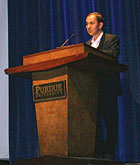
Andreas Athienitis addresses a Purdue University plenary session on solar power, noting its ability to allow a building to be “net zero” when it comes to energy usage.
The conference was in conjunction with the 20th International Compressor Engineering Conference and the 13th International Refrigeration and Air-Conditioning Conference.
Athienitis’ plenary talk encompassed all three conferences and was titled, “Modeling, Design, and Control of Solar and Zero-Energy Buildings in Canada.” His paper was in conjunction with his Concordia colleague Jose Candanedo and was presented during a seminar titled “Net Zero Energy Buildings” in the Buildings Conference tract.
PLENARY
In the plenary talk, Athienitis said that if such buildings take a solar approach, that could mean “easy pickings” for advocates given issues related to hydropower, fossil fuels, and nuclear energy.“The annual solar energy incident on a roof of a typical house far exceeds its total energy consumption. And any building should produce as much energy as it uses,” he said.
He said net zero energy solar buildings could be possible by 2030. To make it happen, “it is necessary to have solar optimization, in which solar technology is integrated into building design and operation.”
Specifically, he said, “The integration of solar technology with HVAC can be done. But we must avoid looking at solar as just an add-on. It needs to integrate.”
One aspect of the integration is in the design of the house, he said. Instead of potentially unsightly solar panels, he noted such technology could be incorporated into the roof, as he said was done at his home in the Montreal area.
Currently, he said, it would be best if such homes were prefabricated before being brought to a site, to curb costs. Likewise, persons considering such as option should look for credits, such as putting excess power from solar into the electrical grid.
PAPER
In the paper, Candanedo and Athienitis said, “Solar homes are defined here as those using solar radiation to meet a considerable fraction of their energy needs with solar heat gains and active solar energy systems (such as PV panels and solar thermal collectors). Advanced control strategies can be used in these houses to manage the highly variable solar resource, by taking advantage of passive storage in the building’s thermal mass and active thermal energy storage systems.”The paper went on to show what were described as “simplified linear models for predictive control of advanced solar homes with passive and active thermal storage.”
The models, “created through system identification of building simulation software results, have been presented as a practical methodology for developing and testing control strategies for advanced solar homes. It has been shown that these transfer functions can satisfactorily model the response of a building with significant solar gains. Control strategies may include both supervisory control, based on the optimal selection of set-point sequences, and lower level control (such as model predictive control).”
Publication date:08/30/2010




